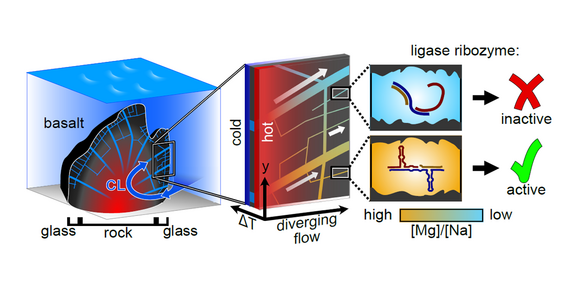Interdisciplinary Research Team Investigates Role of RNA in the Origins of Life
- Research
- Top News

Was life as we know it today preceded by a world based on RNA as a universal building block and only later replaced by DNA? An interdisciplinary research team from Dortmund and Munich is investigating the role that ribonucleic acid (RNA) might have played in the origins of life. The work shows how, under realistic geological conditions, physical non-equilibrium processes could have encouraged processes that might have been significant for the origins of life. Their findings were published recently in the prestigious journal Nature Chemistry.
While in today’s life forms deoxyribonucleic acid (DNA) contains the blueprint of proteins, the nanomachines of life, in the hypothesis of the RNA world its sister polymer plays a central role. The hypothesis assumes that life developed out of self-replicating RNA molecules which existed before the evolution of DNA and proteins. RNA can be both – an information store and a nanomachine. This makes it particularly interesting as a candidate for the first biopolymer of life because in principle it can, as a consequence, copy the sequence of other RNA strands and thus could have triggered the process of Darwinian evolution.
To be able to fulfill its task as a nanomachine, RNA must, however, fold into a correct and thus active form (similarly to proteins) – a process for which it places specific demands on its environment. In particular, it requires a relatively high concentration of doubly charged magnesium ions and a concentration of singly charged sodium ions which is as low as possible because the latter can lead to misfolding of the RNA strands. To date, however, it was unclear how such beneficial conditions could be produced through prebiotically plausible processes.
Research collaboration between biophysics, geosciences, and chemical biology
In an interdisciplinary research approach, scientists from LMU Munich and TU Dortmund University working in biophysics, geosciences, and chemical biology have now succeeded in showing how the correct ratio of magnesium and sodium ions for RNA folding could be achieved by natural processes from basalt, widely available then as it is today, and simple heat flows.
For this purpose, first of all the geosciences group led by Don Dingwell and Bettina Scheu (LMU) synthesized basalt samples in different physical states, i.e., rock or glass. Basaltic glass is obtained through the rapid cooling of molten basalt, a natural process that has taken place continuously on Earth since the oceans first existed. In a second step, the biophysicists in the working group led by Dieter Braun and Christof Mast (LMU) studied the quantities of magnesium and sodium ions that could be precipitated under a wide range of parameters, such as temperature or grain size of the geomaterial. The results showed that in all cases significantly more sodium ends up in the water than magnesium – the latter in far lower concentrations than needed for RNA nanomachines.
However, if we now look at the full picture with heat flows, which were most likely present due to the high level of geological activity, the situation changes considerably. In the fine channels, like are easy to find in basaltic glass, such a heat flow leads to the simultaneous convection of the water and a drift of the salt ions against the heat flow. This effect, known as thermophoresis, is greatly dependent on the valency and size of the ions. In combination, convection and thermophoresis ultimately lead to a higher local accumulation of magnesium ions than of sodium ions. The researchers were able to show that the different degrees of concentration of the salts increase with the size of the overall system.
The working group led by Hannes Mutschler (TU Dortmund University) provided the corresponding test systems in the form of catalytically active RNA strands (ribozymes). In particular, the team was able to show that thermophoretic conditions vastly improve a model ribozyme’s self-replication. They also observed the same effect for another ribozyme which, influenced by thermophoresis, was able to link several short RNA strands and thus produce very long RNA molecules. Through the separation of the sodium and magnesium ions, as occurs in thermophoretic systems, these two fundamental biological activities were also far more effective. Even very large quantities of excess sodium in the range of 1000:1 compared to magnesium, which are assumed in some prebiotic scenarios and incompatible with RNA catalysis, can be balanced out through the scenario presented in the paper, thus allowing the ribozymes to do their job nonetheless.
Contact for further information:





![[Translate to English:] Partner Four hands are holding the green logo of TU Dortmund University](/storages/tu_website/_processed_/1/d/csm_Partner_Nicole_Rechmann_KW_40b35bb3fd.jpg)




![[Translate to English:] Forschung An apparatus with tubes in a laboratory](/storages/tu_website/_processed_/0/c/csm_Forschung_Juergen_Huhn_cbd34afd6d.jpg)
![[Translate to English:] Studium Five students are sitting in a lecture hall. They are talking to each other.](/storages/tu_website/_processed_/c/9/csm_Studium_FelixSchmale_81d94adc86.jpg)





